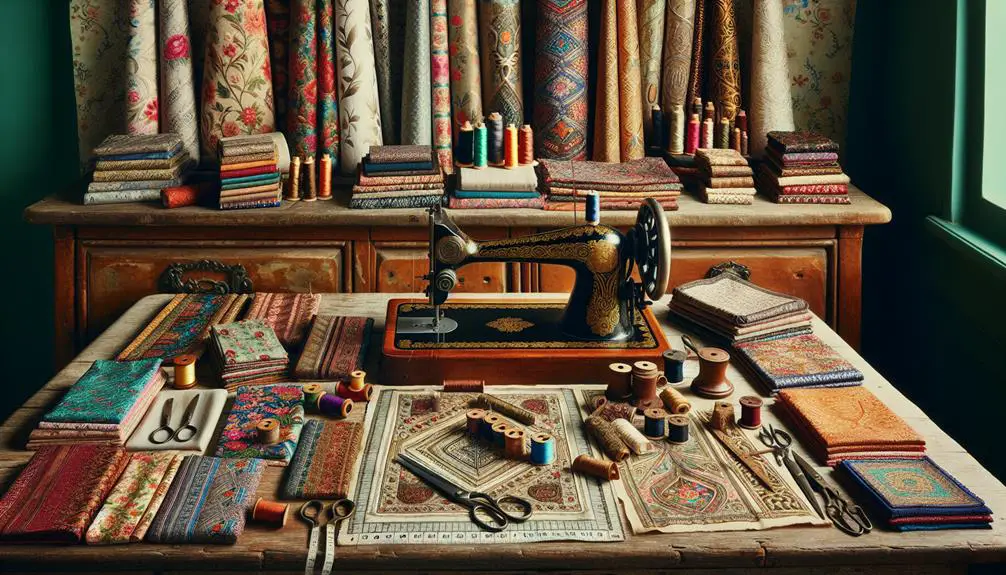In a world dominated by fast fashion, the resurgence of vintage fabrics presents a revitalizing juxtaposition, blending nostalgia with modern sensibilities. You might wonder why these materials, from luxurious silk to rugged tweed, are becoming so popular again. Beyond their undeniable charm, vintage fabrics offer historical significance and sustainable benefits that today's conscious consumers can't ignore. How can these retro materials be seamlessly integrated into contemporary style and interior design? The answers might surprise you.
Table of Contents
Key Takeaways
- Vintage fabrics honor cultural heritage and reflect timeless artistry and craftsmanship.
- Popular vintage fabrics include silk, velvet, and tweed, each offering unique textures and styles.
- Embracing vintage fabrics supports sustainable fashion by reducing new fabric production and decreasing the carbon footprint.
- Mixing vintage and modern elements creates unique looks and adds character to both fashion and interior design.
- Vintage fabrics in interior design add charm and sophistication through retro-inspired accents and sustainable design choices.
Historical Significance
Vintage fabrics aren't just stylish; they're steeped in history that tells the story of our cultural heritage. When you wear or even just appreciate vintage textiles, you're not merely indulging in a fashion trend. You're honoring the artistry and craftsmanship that have defined generations.
Each fabric carries the imprint of its time, reflecting the cultural appreciation of its era. It's a way for you to connect with the past in a tangible, meaningful way.
Consider how the fashion industry has evolved. While modern fabric production often prioritizes speed and cost-efficiency, vintage fabrics represent a different ethos. These materials were made with painstaking attention to detail, often by artisans who dedicated their lives to perfecting their craft.
By choosing vintage, you're celebrating that dedication and acknowledging the rich history embedded in each thread.
Moreover, your appreciation for vintage fabrics can be a powerful statement against the sometimes disposable nature of today's fashion industry. You're making a choice that values quality over quantity, and history over fleeting trends.
This conscious decision elevates your personal style while contributing to a broader cultural appreciation for the enduring beauty and significance of vintage textiles.
Popular Vintage Fabrics
Some of the most popular vintage fabrics include silk, velvet, and tweed, each bringing a unique charm and history to your wardrobe. Silk, with its luxurious texture and sheen, has long been favored by royalty and fashion icons. It's an iconic textile that effortlessly elevates any outfit.
Velvet, known for its rich, plush feel, adds a touch of opulence and drama, perfect for evening wear.
Tweed, with its rugged yet sophisticated appeal, originated in the Scottish Highlands and remains a staple for both casual and formal attire.
To master the art of incorporating these vintage fabrics into your wardrobe, consider the following:
- Silk Scarves: Reimagining classics, a silk scarf can be tied in various ways to add a modern twist to your ensemble.
- Velvet Blazers: A velvet blazer is a statement piece that combines old-world charm with contemporary fashion trends.
- Tweed Skirts: Tweed skirts offer both versatility and timeless elegance, making them suitable for various occasions.
Sustainability Benefits
Incorporating vintage fabrics into your wardrobe not only adds unique style but also supports sustainable fashion practices. By choosing vintage, you're directly contributing to eco-friendly fashion. Instead of purchasing new materials, you're reusing what already exists, reducing the demand for new fabric production, which often involves harmful chemical processes and significant water usage.
Embracing vintage fabrics allows you to participate in upcycling projects, giving old textiles a new lease on life. You can transform a forgotten 70s dress into a chic modern top or turn vintage curtains into stylish skirts. Such creative reuse not only minimizes waste but also showcases your imaginative flair.
Additionally, opting for vintage fabrics helps decrease the carbon footprint associated with transporting new materials across the globe. Each piece of vintage fabric you integrate into your wardrobe represents one less garment that needs to be manufactured and shipped, thereby conserving energy and reducing emissions.
Styling Vintage Fabrics
When styling vintage fabrics, you can mix old pieces with modern ones to create a unique look. Bold patterns in vintage fabrics will make you stand out, while accessories with a vintage touch can complete your outfit.
Embrace the charm of the past and make it your own.
Mix Old With New
Blending vintage fabrics with modern pieces creates a unique and stylish look that stands out in any wardrobe. By combining the charm of yesteryear with contemporary elements, you can craft outfits that are both timeless and trendy. The key is to add modern twists that breathe new life into classic materials.
Consider these strategies to master eclectic pairings:
- Contrast Textures: Pair a vintage silk blouse with modern leather pants. The juxtaposition of soft and tough textures adds depth and interest to your ensemble.
- Update Silhouettes: Combine a vintage A-line skirt with a sleek, fitted top. This mix not only modernizes the look but also highlights the best of both worlds.
- Accessorize Thoughtfully: Use contemporary accessories like minimalist jewelry or a structured handbag to modernize vintage outfits subtly.
Bold Patterns Stand Out
Bold designs on vintage textiles can instantly elevate your outfit, creating a striking statement that's hard to overlook.
To master the art of styling these bold designs, start by understanding how modern interpretations can breathe new life into classic designs. Look for garments that incorporate contemporary twists while still honoring the traditional motifs that make vintage textiles so timeless.
When selecting a piece, consider how its bold designs can be balanced with more subdued elements in your wardrobe.
Pair a vibrantly designed vintage blouse with tailored, neutral trousers for a sophisticated look that blends the old with the new. Alternatively, a vintage dress with a captivating print can serve as the focal point of your ensemble, requiring only minimal accessories to complete the look.
Additionally, don't shy away from mixing different bold designs.
The key is to ensure that there's a unifying element, such as a common color palette or similar pattern scale.
Accessorize With Vintage Touches
To complete your look with vintage fabrics, accessorize with pieces that echo the era's charm and character. By blending vintage lace with modern accessories, you create a dynamic style that stands out. Think about pairing a lace-trimmed blouse with a sleek leather belt or contemporary jewelry.
Retro prints can also be enhanced with a contemporary twist. A bold, 70s-inspired floral dress looks fresh when matched with minimalist shoes or a structured handbag. Don't shy away from mixing eras for a unique and polished appearance.
Here are three standout ways to accessorize with vintage touches:
- Scarves and Bandanas: A vintage silk scarf tied around your neck or as a headband instantly adds a touch of old-world elegance. Pair it with modern sunglasses for a chic look.
- Jewelry: Statement pieces like brooches or chandelier earrings can transform a simple outfit. Look for items that feature vintage lace details or retro prints.
- Handbags: Opt for vintage-inspired handbags such as beaded clutches or structured satchels. These pieces not only complement vintage fabrics but also bring a refined edge to your ensemble.
Mastering these combinations guarantees your vintage-inspired look remains timeless yet relevant.
Vintage in Interior Design
You can transform your home with vintage fabrics by embracing timeless patterns, making sustainable design choices, and adding retro-inspired accents.
These elements bring a unique charm and character to any space.
Let's explore how these vintage touches can elevate your interior design.
Timeless Patterns Revival
Incorporating timeless vintage patterns into your interior design can instantly add character and charm to any space. By blending modern interpretations with classic designs, you can create an environment that feels both nostalgic and fresh.
Vintage patterns like florals, damasks, and paisleys offer a rich history that, when combined with contemporary twists, breathe new life into traditional motifs.
To masterfully revive timeless patterns, consider the following strategies:
- Mix and Match: Combine different vintage patterns to create a layered, eclectic look. Pairing a bold damask wallpaper with a subtle floral upholstery can create striking yet harmonious contrasts.
- Accents and Accessories: Use vintage patterns in smaller doses like throw pillows, curtains, or rugs. This allows you to introduce classic designs without overwhelming your space, giving it a sophisticated touch.
- Reimagined Furniture: Upholster modern furniture with vintage fabrics. This fusion of contemporary twists and traditional motifs can result in unique statement pieces that are both stylish and timeless.
Sustainable Design Choices
Embracing vintage fabrics not only adds character to your home but also supports sustainable design by reducing waste and promoting the reuse of materials.
When you choose vintage, you're making a conscious decision to incorporate eco-friendly materials into your living space. These fabrics, often made from high-quality, enduring textiles, have stood the test of time and continue to offer durability and aesthetic appeal.
Opting for vintage fabrics means you're not contributing to the demand for new textiles, which often involve resource-intensive processes and unethical production practices. Instead, you're giving existing materials a new lease on life, reducing your carbon footprint significantly. You're also sidestepping the environmental costs associated with manufacturing new fabrics, such as water consumption, chemical use, and greenhouse gas emissions.
Moreover, vintage fabrics often embody craftsmanship and detail that mass-produced items lack. By integrating these into your interior design, you're fostering a home environment that values quality and history.
This approach not only enriches your space but also aligns with a broader commitment to sustainable living. By mindfully selecting vintage, you're ensuring that your design choices reflect both style and ethical responsibility.
Retro-Inspired Accents
To bring a nostalgic charm to your interiors, add retro-inspired accents that capture the essence of vintage design. By combining modern twists with timeless elements, you can create a space that feels both classic and fashion forward. Here's how you can master this sophisticated blend:
- Furniture: Opt for mid-century modern pieces, characterized by clean lines and organic shapes. Think teak wood finishes, tapered legs, and bold upholstery colors. These pieces offer a retro vibe with a contemporary edge.
- Textiles: Integrate vintage fabrics like velvet, brocade, and chintz. Drapes, cushions, and throws in these materials can instantly evoke a bygone era while complementing modern aesthetics. Don't shy away from mixing patterns for a truly eclectic look.
- Decorative Elements: Seek out unique, retro-inspired items such as sunburst mirrors, rotary phones, and record players. These accessories not only serve as conversation starters but also enhance the nostalgic ambiance of your space.
Where to Find Vintage Fabrics
You can discover an array of vintage fabrics at local thrift stores, online marketplaces, and specialized vintage shops. Thrift stores often house hidden gems waiting to be unearthed by a discerning eye. Don't overlook these troves of history; they can offer unique finds at a fraction of the cost.
Online marketplaces like Etsy and eBay are also excellent resources, providing access to global sellers who specialize in vintage textiles. These platforms allow you to filter searches by era, material, and price, ensuring you find exactly what you need.
For a more curated selection, visit specialized vintage shops. These stores typically have knowledgeable staff who can guide you through their collections, offering insight into the history and care of each fabric. Many of these shops also host online stores, providing you with even more options to explore from the comfort of your home.
Additionally, attending vintage fairs and textile shows can be a rewarding experience. These events gather vendors from various regions, giving you the opportunity to physically inspect the fabrics and negotiate prices. With these diverse sources, you'll master the art of sourcing vintage fabrics in no time.
Frequently Asked Questions
How Do I Properly Care for Vintage Fabrics to Ensure Longevity?
You should focus on proper storage, gentle washing, and expert repairs for vintage fabric care. Use preservation techniques like storing in cool, dry places and avoid direct sunlight to guarantee your vintage fabrics last longer.
What Are Some Common Challenges Faced When Sewing With Vintage Fabrics?
You'll face challenges like fabric preservation, delicate sewing techniques, and tricky fabric sourcing. Mastering pattern selection is vital to avoid damaging the material. Ensuring proper care and handling will help you overcome these hurdles effectively.
How Can I Differentiate Between Authentic Vintage and Vintage-Inspired Fabrics?
To differentiate, examine the fabric quality and weave for vintage authenticity. Authentic vintage fabrics often show natural wear and unique textures. Vintage-inspired designs feature modern interpretations, with newer materials and consistent patterns indicating recent production.
Are There Any Specific Tools Required for Working With Vintage Fabrics?
You'll need modern tools to handle vintage fabrics effectively. Essential equipment for vintage fabrics includes a sharp rotary cutter, high-quality needles, and a steam iron. These tools guarantee precision and maintain the fabric's integrity.
Can Vintage Fabrics Be Dyed or Altered Without Ruining Their Value?
You can dye or alter vintage fabrics, but use careful dyeing techniques and preservation methods. Consider alteration possibilities and value concerns. Mastery in these areas guarantees you enhance, not ruin, the fabric's intrinsic value.
- How Does Ring Spun Cotton Affect Garment Fit and Shape Retention? - August 13, 2024
- What Are the Challenges in Producing Ring Spun Cotton? - August 13, 2024
- Is Ring Spun Cotton Suitable for Plus-Size Clothing? - August 13, 2024







